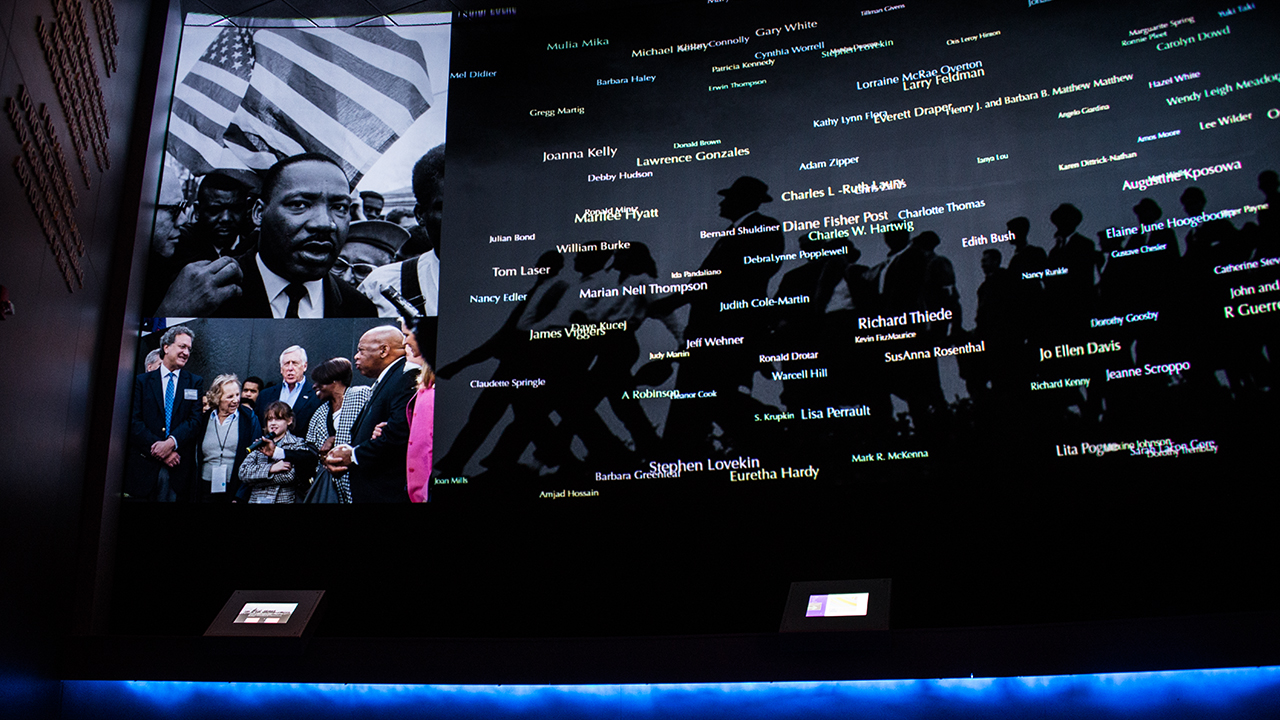The four galleries at the Civil Rights Memorial Center focus on the modern civil rights movement (1954-1968), the stories of the martyrs honored on the Civil Rights Memorial, contemporary social justice issues, and a space of reflection.
The Martyr Room
Inside the Martyr Room, visitors will learn about the 40 people whose names are inscribed on the Civil Rights Memorial. Some of the names – such as King, Medgar Evers, Viola Liuzzo and Emmett Till – are well known. Others, such as the Rev. George Lee and Willie Brewster, are names that visitors might not recognize. They include students, farmers, ministers, truck drivers, a deputy sheriff and a Nobel laureate – and range in age from 11 to 66. Thirty-two were Black; eight were white. Most were ordinary people with extraordinary courage and conviction. Some were targeted because of their civil rights work. Some were random victims of white supremacists determined to halt the movement through violence. And others were people who, in the sacrifice of their own lives, brought new awareness to the brutality and injustice faced by Black people in the Jim Crow-era South.
The gallery includes a short video projection, The March Begins, an interactive Martyr Table, the Wall of the Forgotten and a Memorial Overlook interactive.
The March Begins:
The 5-minute video projection deepens visitors’ understanding of the racial oppression during the Jim Crow era and highlights key events of the civil rights movement and the violent, white supremacist resistance it confronted.
Martyr Table:
A glowing, abstract, stained-glass interactive exhibit tells the story of each person listed on the Memorial and aims to deepen visitors’ understanding of their individual sacrifices.
Memorial Overlook:
The Memorial Overlook allows visitors to explore Maya Lin’s concept behind the Memorial’s design and its symbolism. It also highlights Julian Bond, who served as the first president of the SPLC’s board of directors.
The Forgotten:
The Wall of The Forgotten lists the names of 74 women, men and children who died between 1952 and 1968 under circumstances suggesting they were victims of white supremacist violence. It was inspired by Shelton Chappell’s request to honor the memory of his mother, Johnnie Mae Chappell, among the other martyrs listed on the Memorial. Like Johnnie Mae Chappell and many of the other martyrs, justice never came for those listed on the Wall of the Forgotten.
Learn more about the civil rights martyrs here.
Apathy is Not an Option: Orientation Theater
The Orientation Theater connects the civil rights movement of the 1950s and 1960s to social justice activism today. Upon entering, visitors are surrounded by imagery both past and present to create an immersive experience that inspires and encourages people to discover their own ways to help bring about social change. The original film “Apathy is Not an Option,” which is continuously screened, combines archival and contemporary footage to educate and inspire a new generation of social justice activists.
The March Continues: Today’s Activist
In this hallway, visitors are introduced to contemporary civil and human rights challenges, with a focus on issues the SPLC is addressing through its work. Through this interactive experience, visitors will learn more about the power of grassroots organizing and mobilization to help them understand that ordinary people can make a difference.
Wall of Justice: A Space of Reflection
On the Wall of Justice, the multicolored, digitally displayed names of more than half a million people cascade continuously down a 20-by-40-foot screen in a simulation of the water flowing over King’s words on the Memorial outside. Each name was added by someone who has visited the CRMC and made a personal decision to work for justice in their own life. In addition, a large monitor displays “A Civil Community,” a poem compiled by Kwame Alexander from reflections submitted by people from all walks of life who shared their vision for America. Students, teachers, activists, parents and children from across the country contributed nearly 1,000 poems for the new exhibit. It is a testament to people, past and present, who are committed to making manifest the ideals of justice, equity, diversity and inclusion for all.



